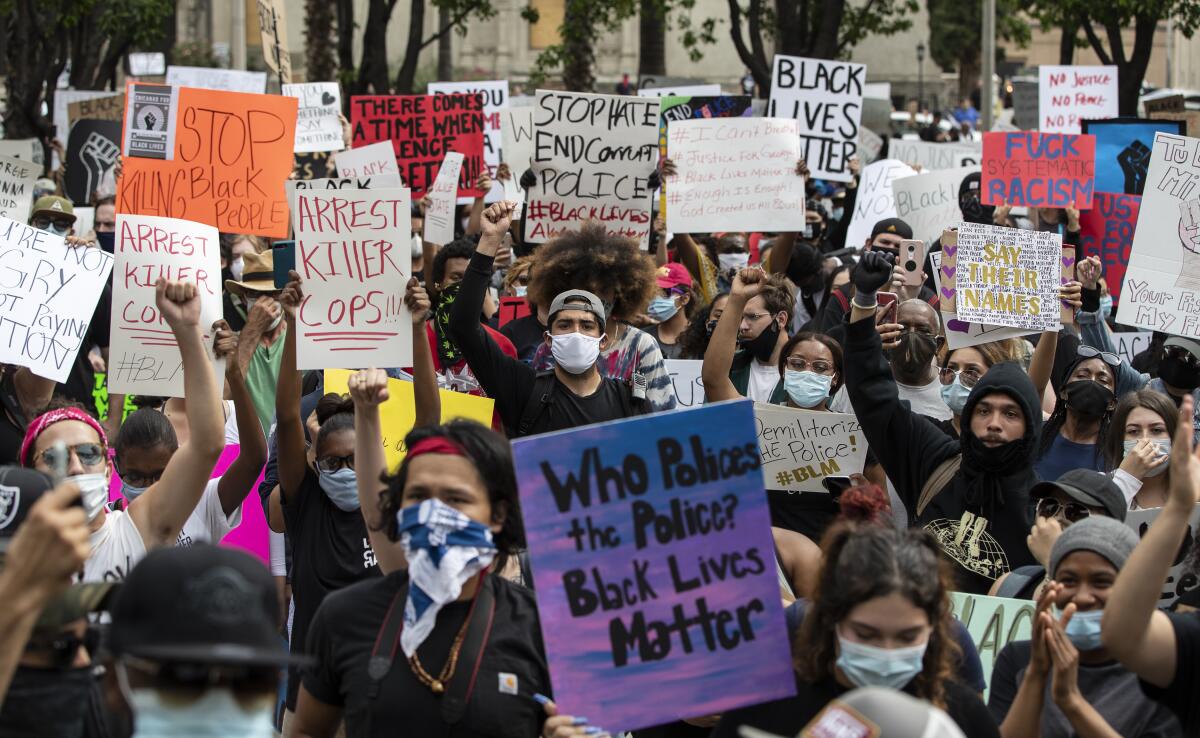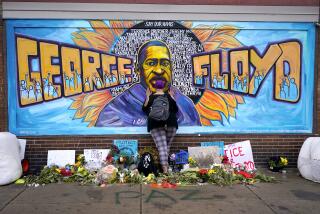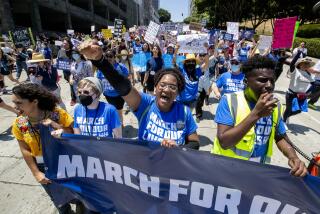Inland Empire protests fueled by cases of past police violence

- Share via
When Mark Ocegueda joined a downtown San Bernardino protest Sunday night, he was compelled by the death of George Floyd in Minneapolis, his neck pinned under the knee of a police officer.
But he was also thinking of 38-year-old Cal State San Bernardino graduate student Bartholomew Williams, a black man who suffered from bipolar disorder and was shot and killed by campus police in 2012. And about Diante Yarber, a 26-year-old black man shot and killed in a fusillade of police bullets in the parking lot of a Barstow Walmart in 2018. And about Tyisha Miller, a 19-year-old black woman killed by police as she sat in her car at a local gas station 22 years ago.
Across the nation, protesters have gathered in an outpouring of anger and demands for justice in the death of George Floyd. Major rallies are unfolding in the nation’s largest cities — such as Los Angeles, where five days of civil unrest in 1992 ravaged the city following the acquittal of police officers in the beating of Rodney King.
But protests are also taking place in smaller suburbs and communities with their own histories of racism and police violence that have led to calls for change and accountability. The memory of those cases continues to motivate many who are taking to the streets and calling for local changes.
“I could have gone to Los Angeles or Long Beach to protest, but I wanted to participate in my local community and what they had to say about what’s going on,” said Ocegueda, who is a historian at Brown University and has been staying with family in San Bernardino, where he was raised. “There’s also a notorious record of police violence toward black people and people of color here.”
In the Inland Empire, protesters have gathered in San Bernardino, Moreno Valley, Corona, Temecula, Rancho Cucamonga, Fontana and other communities saying they feel moved — even as they wear masks to protect against the coronavirus — to speak out in the wake of the Floyd case.
The protests have been mostly peaceful, though in some cases there has been looting, vandalism and damage to businesses and a number of arrests for violating curfew. In Riverside on Monday, about 5,000 protesters gathered downtown, many of them young people who said they were tired of constant stories about black people killed by police, locally and nationally.
“I don’t want to see another black face on the news. I don’t know if I’m next,” said Christiana Ellis, 15, who attended the protest with her mother, Sherry Morton, 51. “I wonder, what if my dad is out driving to get groceries, and he gets pulled over for a speeding ticket and ends up in a casket?”
Ellis, who attends Martin Luther King High in Riverside, said she was also thinking about recent incidents close to home — like the students at her school who posed with a swastika and a Confederate flag in a photo that circulated on social media in February, sparking fear and anger on campus.
“My brother went to King 20 years ago and someone drew a swastika on his jacket,” she said. “That just tells me there hasn’t been much change.”
Rep. Mark Takano (D-Riverside) said his own memories of the 1998 Miller case were part of what pushed him to go to Monday’s protest in Riverside and speak to protesters.
“I remember the outrage,” Takano said. “How was it that a black woman alone in her car at a gas station was shot multiple times and killed?”
Miller was killed by white police officers a few days after Christmas. She had passed out in her disabled car and had a gun on her lap. Responding officers said she appeared to grab the gun when they tried to wake her.
The officers fired nearly two dozen shots, hitting her 12 times.
Deborah Wong, a professor of music at UC Riverside, vividly recalls the tumultuous year that followed Miller’s death.
“There was one public protest after another,” Wong said.
The officers were eventually fired but prosecutors declined to file criminal charges. And in the aftermath, the state attorney general ordered Riverside’s police department to undergo sweeping reforms and the city created the Community Police Review Commission, an independent review board.
That board still exists. But in Wong’s opinion it has been “very nearly completely defanged.”
A representative of the board could not be reached for comment.
In the Williams case, the Cal State San Bernardino grad student who was working on his second master’s degree was reportedly acting confused and distressed when officers went to his off-campus dorm room in response to a call. An altercation ensued when officers tried to take him to a hospital and the officers said Williams exhibited “super-human-type strength.”
Williams’ death also sparked protests and in 2014, the California State University Board of Trustees agreed to pay $2.5 million to Williams’ family, revise the school’s crisis intervention policies and require police officers to undergo crisis intervention training. But prosecutors declined to charge the officers.
Ocegueda, who is a graduate of Cal State San Bernardino, says the case might have gotten more attention had it not happened in the Inland Empire.
“To me the killing of Bartholomew Williams was such an outrageous use of excessive force that I was very upset to see that it was kind of brushed under the rug,” he said. “I think part of that is because the media has so long ignored these places outside of Los Angeles and Orange County. But the residents of the city, they definitely remember that incident.”
In the Yarber case, the 26-year-old was driving in a Walmart parking lot when officers fired 30 rounds into his car. The shooting, which was captured on a grainy cellphone video, received national attention and again sparked local protests. Prosecutors declined to file charges against the officers, saying they “each had an honest and objectively reasonable belief that Yarber posed a threat of serious bodily injury or death to themselves.”
Ben Reynoso, 28, an organizer with Inland Congregations United for Change and a candidate for city council in San Bernardino, said people in the community want justice for Floyd and are also hoping that the case can be a catalyst for local change.
On Tuesday morning, he and others from around the Inland Empire went to the San Bernardino County Board of Supervisors for a rally to demand that the county declare racism a public health crisis, saying it’s long past time for the community to start looking seriously at issues of police violence and environmental, health and educational disparities that are affecting communities of color throughout the Inland Empire.
“I along with a lot of other black people are just tired. We’re out there in the streets, but a lot of us can’t even chant because we’re tired,” Reynoso said. “It’s like you’ve been shaking a Coke can for such a long time what do you expect to happen? It’s going to blow up.”
Following the rally, the supervisors agreed to consider a resolution declaring racism a public health crisis next week.
Times staff writer Stephanie Lai contributed to this story.
More to Read
Sign up for Essential California
The most important California stories and recommendations in your inbox every morning.
You may occasionally receive promotional content from the Los Angeles Times.










